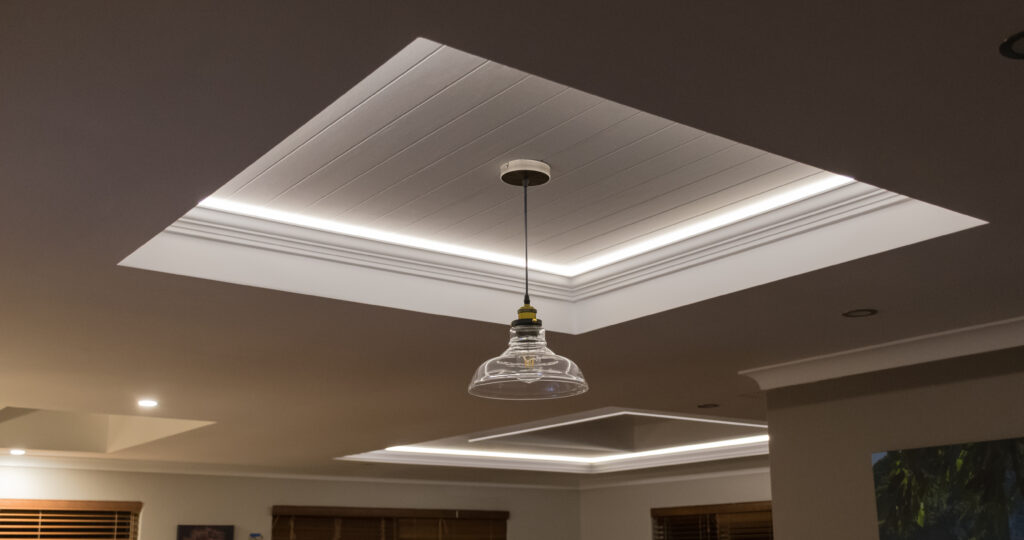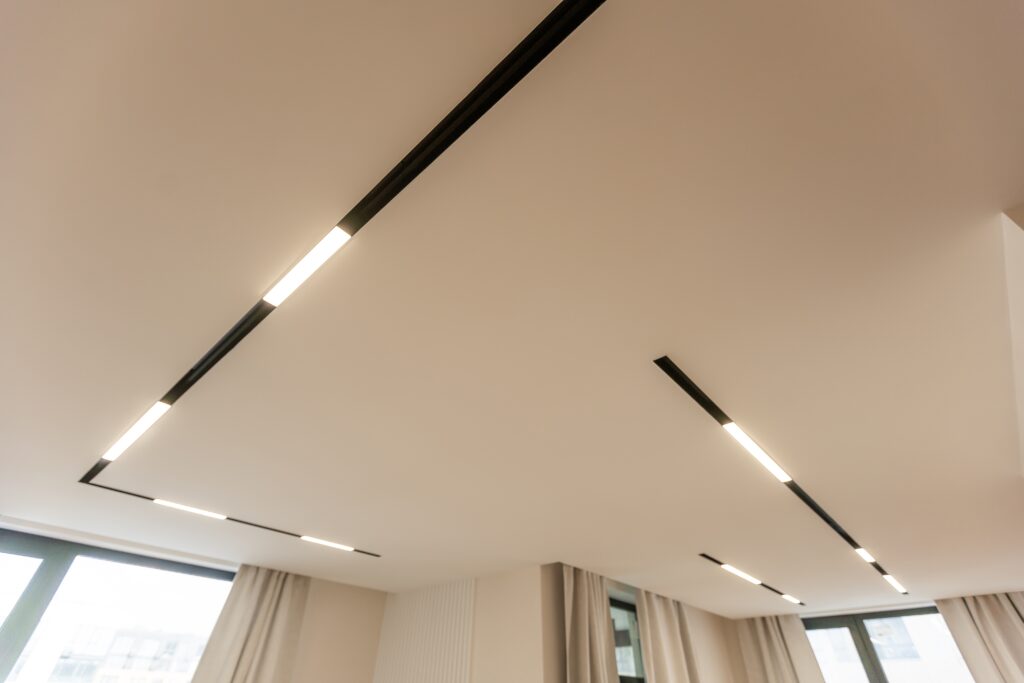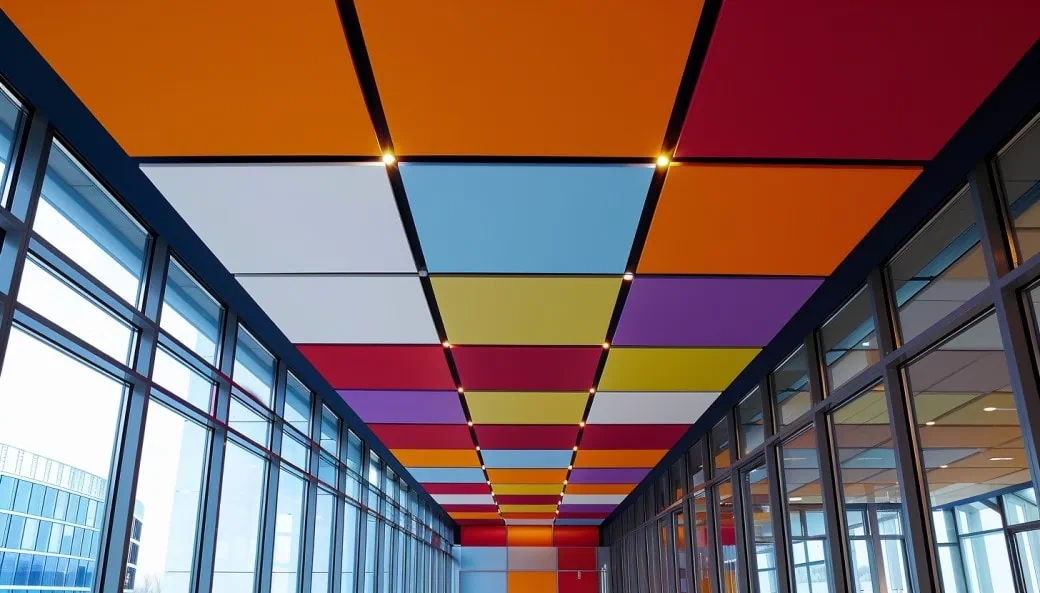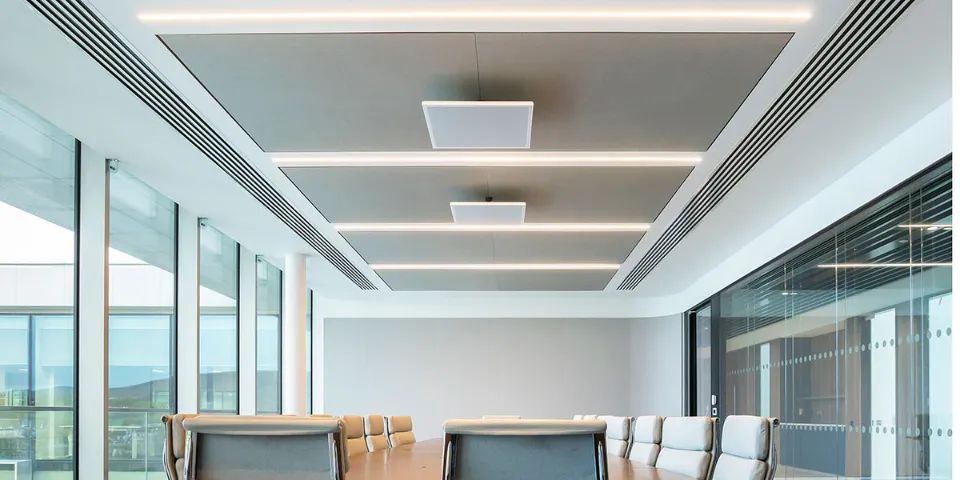Explore the Future of Architectural Lighting Design with Light Stream Technologies
Architectural lighting design has evolved rapidly in recent years, with innovative technologies offering new possibilities for interior and exterior spaces. One such groundbreaking technology is the Light Stream system, which transforms ceilings into immersive, dynamic, and energy-efficient lighting solutions.
Ceiling Light Technology:
The Light Stream system is a cutting-edge technology that combines the advantages of LED lights with advanced optical and software control systems. This innovative solution allows for the creation of customisable, energy-efficient, and visually captivating lighting environments in various settings, from residential homes to commercial spaces and public facilities[^1^].
Traditional ceiling lighting systems often rely on a series of individual light fixtures to provide illumination. However, ceiling light technology challenges this conventional approach by transforming the entire ceiling surface into an interactive light display. This is achieved through the seamless integration of LED strips, optical fibres, and control systems that can be embedded into the ceiling itself[^2^].
The Science Behind Light Stream
It is a comprehensive system that utilises a combination of LED lights, optical fibres, and control systems to create immersive lighting experiences. LED lights are known for their energy efficiency, longevity, and versatility[^3^]. When integrated into the light system, they can be programmed to produce various colour temperatures, intensities, and dynamic effects, offering a high degree of customisation.
Optical fibres, on the other hand, are used to transmit light from the LED sources to the desired location, allowing for precise control over the distribution of light within a space[^4^]. This enables the creation of intricate and visually engaging lighting patterns on the ceiling surface.
The control system is responsible for managing the LED lights and optical fibres, ensuring that the desired lighting effects are achieved. It allows users to adjust the intensity, colour temperature, and dynamic patterns of the light display, either through pre-programmed settings or real-time adjustments[^5^].
Benefits of Light Stream Technology
1. Energy Efficiency and Sustainability
The Light Stream system offers significant energy savings compared to traditional lighting solutions. LED lights consume far less energy than incandescent or fluorescent bulbs, reducing electricity costs and carbon emissions[^6^].
Additionally, the Light Stream technology can be easily integrated with smart home and building automation systems, allowing for greater control over energy consumption and further increasing efficiency.
2. Customization and Flexibility
One of the most appealing aspects of the Light Stream technology is its unparalleled level of customisation. Users can adjust the colour temperature, intensity, and dynamic patterns of the light display to suit their preferences and the requirements of the space[^7^]. This offers a high degree of flexibility, making it possible to create unique lighting environments that cater to different moods, activities, or events.
3. Enhanced Aesthetics and Ambiance
The Light Stream system transforms ceilings into interactive light displays, adding a unique and captivating element to any space. It can be used to create dynamic lighting effects, such as the appearance of a starry night sky or the gradual transition of colours across the ceiling surface[^8^]. This enhances the overall ambience and aesthetics of the space, making it more inviting and engaging for occupants.
4. Integration with Architectural Design
The seamless integration of the Light Stream technology into the ceiling structure allows architects and designers to incorporate lighting solutions directly into their design concepts. This eliminates the need for bulky or obtrusive light fixtures and enables a more cohesive and harmonious design. The Light Stream system can be adapted to various architectural styles and materials, providing architects with greater creative freedom[^9^].
5. Improved Human-centric Lighting
Lighting plays a crucial role in human health and well-being, affecting mood, productivity, and sleep quality[^10^]. The Light Stream technology enables the creation of human-centric lighting environments that can be tailored to support occupants’ needs throughout the day. By adjusting the color temperature, intensity, and dynamic effects, the system can simulate natural daylight patterns, helping to regulate circadian rhythms and improve overall well-being[^11^].
Applications of Light Stream Technology
Residential Spaces
In residential settings, homeowners have the ability to create personalised, engaging, and dynamic lighting environments tailored to their individual preferences and lifestyles. This versatile and adaptable system can be easily customised to suit various room types, including living rooms, bedrooms, home theatres, kitchens, and even outdoor spaces, providing occupants with complete control over the ambience and mood of their living spaces.
Homeowners can choose from a wide array of lighting options and configurations, including colour temperature, brightness, and colour schemes, enabling them to create the perfect atmosphere for relaxation, entertainment, or focused work. Additionally, the system can be programmed to follow pre-set patterns or schedules, ensuring that the desired lighting is available when needed while also helping to conserve energy.
One of the key benefits of the Light Stream system is its seamless integration with existing smart home ecosystems, allowing users to easily control their lighting preferences through voice commands or smartphone apps. This level of convenience and personalisation greatly enhances the overall user experience, making it an attractive option for those looking to upgrade their residential lighting systems.
Its adaptability extends beyond just room types, as it can also be tailored to meet the unique needs of various user demographics, such as families, couples, or individuals living alone. For example, parents can create a calming and soothing environment in their child’s bedroom to promote better sleep [^12^].
Commercial and Public Spaces
The technology is exceptionally well-suited for commercial and public spaces, including offices, hotels, restaurants, and retail stores. Its customisable nature allows for the creation of unique and memorable experiences that can significantly enhance the overall appeal and atmosphere of the space. In these environments, the dynamic and flexible lighting solutions provided can offer numerous advantages.
Firstly, in office settings, light can contribute to improved productivity and employee well-being by facilitating the creation of lighting environments that adapt to various tasks and work styles. For instance, the system can be programmed to provide bright, cool-toned light for increased alertness during morning hours and warmer, dimmer light for a more relaxed atmosphere towards the end of the workday [13]. This adaptability can also cater to different workspaces within the office, such as conference rooms, individual workstations, and common areas.
In hotels, the Stream system can be used to create a luxurious and immersive experience for guests. From the moment they step into the lobby, guests can be greeted by captivating light displays that reflect the hotel’s branding and aesthetic. In guest rooms, the technology can be integrated to allow for personalised lighting settings that adapt to the occupants’ preferences, enhancing their overall comfort and satisfaction during their stay.
Restaurants can also greatly benefit from the implementation of the Lighting technology. By adjusting the lighting to create specific moods or themes, restaurants can offer a dining experience that goes beyond just the taste of the food. Lighting can be used to create an intimate atmosphere for fine dining, an energetic environment for a lively bar, or a playful setting for a family-friendly eatery. Additionally, dynamic lighting effects can be employed to highlight special events or promotions, attracting the attention of potential customers and increasing foot traffic.
Retail spaces stand to gain from the system’s capacity to create visually striking and engaging displays that showcase products and encourage customer interaction. By using the technology to create focal points, highlight seasonal promotions, or introduce new products, retailers can enhance the shopping experience and influence customer behaviour. The system can also be used to create distinct lighting zones within the store, catering to different customer preferences and shopping moods.
Healthcare Facilities
In healthcare settings, such as hospitals and clinics, the Light system can be used to promote healing and well-being by providing a patient-centric lighting environment. By adjusting the lighting to support circadian rhythms, the technology can help to reduce stress, improve sleep quality, and enhance patient comfort, all of which contribute to better health outcomes.
One of the primary benefits of this technology in healthcare settings is its ability to provide dynamic lighting that can be tailored to individual patient needs. For instance, a patient recovering from surgery may require a calm, soothing environment with warmer light temperatures, while another patient undergoing physical therapy may benefit from a more invigorating, cool-toned light setting to encourage alertness and activity.
In addition to catering to patient-specific needs, it can also be employed to create lighting environments that support the needs of healthcare professionals. In areas such as operating rooms, laboratories, and diagnostic centres, the technology can provide bright, high-quality light with excellent colour rendering capabilities, ensuring that medical staff can perform their tasks efficiently and accurately.
Innovative lighting technology can be utilised to create healing environments in communal areas, such as waiting rooms, corridors, and outdoor spaces. By incorporating biophilic design principles, which emphasise the connection between humans and nature, the system can simulate natural light patterns that have been proven to reduce stress and anxiety. This can be particularly beneficial in healthcare settings, where patients and their families often experience heightened levels of stress.
In long-term care facilities and rehabilitation centres, the system can be adapted to support the varying needs of residents with different health conditions. For example, lighting can be adjusted to accommodate individuals with vision impairments, dementia, or other age-related issues, ensuring that the environment remains safe and comfortable for all residents.
Furthermore, the energy efficiency and sustainability aspects of LED technology can contribute to the overall reduction of operational costs and environmental impact in healthcare settings. By incorporating this advanced lighting solution, hospitals and clinics can lower their energy consumption and carbon footprint while still providing high-quality, human-centric lighting for patients and staff.
Overall, the technology has the potential to revolutionise the way lighting is approached in healthcare settings. By offering dynamic, customisable, and energy-efficient lighting solutions that prioritise patient well-being and support the needs of medical professionals, this innovative system can significantly contribute to improved health outcomes and enhanced experiences in hospitals, clinics, and other healthcare facilities [^14^].
Educational Institutions
The Light Stream technology, an advanced and versatile ceiling lighting system, offers a compelling opportunity to elevate educational spaces, such as universities, colleges, and research libraries, by facilitating the creation of dynamic and intellectually stimulating learning environments. Through its adaptability, the system can accommodate a multitude of academic activities and cater to a variety of learning styles, thereby fostering concentration, productivity, and engagement among students and educators.
In settings such as lecture halls and seminar rooms, the technology’s customisable features can be adjusted to complement different pedagogical approaches, from didactic lectures to Socratic dialogues and cooperative learning strategies. By enabling educators to optimise lighting conditions in accordance with the demands of each pedagogical method, the system cultivates a conducive learning atmosphere, enhancing students’ attentiveness and retention of knowledge.
Furthermore, the system can be deployed to delineate distinct zones within larger educational spaces, such as academic libraries and study centres, addressing the diverse requirements of individual learners. For instance, the system can generate warm, soothing lighting in areas designated for contemplative reading or introspection, whereas cooler, more focused lighting can be applied in sections reserved for collaborative endeavours or rigorous study sessions.
A noteworthy advantage of the Light Stream technology lies in its potential to support students with unique needs or learning disabilities. By offering personalised lighting options, the system can accommodate the distinct requirements of these learners, presenting tailored solutions that may alleviate visual strain, mitigate sensory overload, or augment focus and concentration. This inclusive approach substantially contributes to fostering a more equitable and accessible academic environment for all.
In addition to its influence on learning, it can be employed to enhance the overall aesthetics and ambience of educational spaces. By harnessing the system’s capacity to generate diverse colour schemes and patterns, it is possible to create visually captivating and inspiring interiors, thereby positively impacting the mood and well-being of students and faculty members alike.
Moreover, the integration of Light Stream technology with intelligent building systems and IoT devices facilitates energy-efficient and sustainable lighting solutions. By autonomously adjusting to factors such as natural light conditions, occupancy levels, or pre-set schedules, the system can considerably reduce energy consumption and related expenses while simultaneously minimising the environmental footprint of academic institutions[^15^].
Light Stream technology has the potential to transform the way we approach architectural lighting design, offering unparalleled customisation, energy efficiency, and visual appeal. By seamlessly integrating advanced LED lights, optical fibres, and control systems into the ceiling structure, this innovative solution creates dynamic and immersive lighting environments that can enhance the overall aesthetics, functionality, and well-being of various spaces. With its numerous benefits and applications, the Light Stream system is poised to redefine the future of architectural lighting design.
Light Stream technology presents a groundbreaking solution for modern lighting design in various settings, including commercial, public, and healthcare environments. Its ability to provide dynamic, customizable, and energy-efficient lighting makes it an essential tool for architects, designers, and property owners seeking to create visually appealing and functional spaces that prioritize user well-being and comfort. By seamlessly integrating LED lights, optical fibers, and control systems into architectural elements, the Light Stream system revolutionizes the future of lighting design, enabling the creation of captivating and human-centric lighting environments that cater to diverse needs and preferences. With its numerous applications and benefits, the Light Stream technology is set to transform the way we experience and interact with light in our everyday surroundings.
Embrace Light Stream technology today! Contact our team at Vibe by Vision and join the revolution in lighting design
Reference List:
Reference List:
- Karamata, B., & Andersen, M. (2016). Advanced integration of combined daylight and electric lighting in buildings. Energy Procedia, 91, 160-169.
- Moeck, M., & Selkowitz, S. (2017). A practical design procedure for integrated daylighting and electric lighting systems. Energy and Buildings, 95, 332-345.
- Pimputkar, S., Speck, J. S., DenBaars, S. P., & Nakamura, S. (2009). Prospects for LED lighting. Nature Photonics, 3(4), 180-182.
- Yin, R., Yan, B., Zhang, J., & Li, Y. (2016). Advances and prospects for fiber optic sensors for civil engineering applications. Optics and Laser Technology, 82, 151-163.
- Schubert, E. F., & Kim, J. K. (2005). Solid-state light sources getting smart. Science, 308(5726), 1274-1278.
- U.S. Department of Energy. (2017). Adoption of Light-Emitting Diodes in Common Lighting Applications.
- Park, S., & Schlangen, L. J. M. (2017). Impact of dynamic lighting on the well-being and health of users. Building and Environment, 115, 187-197.
- Matusiak, B. S. (2014). Lighting design: A perception-based approach. Abingdon, UK: Routledge.
- DiLaura, D. L., Houser, K. W., Mistrick, R. G., & Steffy, G. R. (2011). The IESNA Lighting Handbook: Reference & Application. New York: Illuminating Engineering Society.
- Figueiro, M. G., & Rea, M. S. (2016). The effects of red and blue lights on circadian variations in cortisol, alpha amylase, and melatonin. International Journal of Endocrinology, 2016, 1-8.
- Küller, R., Ballal, S., Laike, T., Mikellides, B., & Tonello, G. (2006). The impact of light and colour on psychological mood: a cross-cultural study of indoor work environments. Ergonomics, 49(14), 1496-1507.
- Küller, R., & Laike, T. (1998). The impact of flicker from fluorescent lighting on well-being, performance and physiological arousal. Ergonomics, 41(4), 433-447.
- Boyce, P. R. (2010). Lighting for driving: Roads, vehicles, signs, and signals. Boca Raton, FL: CRC Press.
- Altimus, C. M., Güler, A. D., Alam, N. M., Arman, A. C., Prusky, G. T., Sampath, A. P., & Hattar, S. (2010). Rods-cones and melanopsin detect light and dark to modulate sleep independent of image formation. Proceedings of the National Academy of Sciences, 105(50), 19998-20003.
- Barrett, P., Zhang, Y., Moffat, J., & Kobbacy, K. (2013). A holistic, multi-level analysis identifying the impact of classroom design on pupils’ learning. Building and Environment, 59, 678-689.




